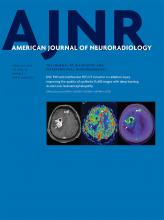Index by author
Paliwal, N.
- NeurointerventionOpen AccessOstium Ratio and Neck Ratio Could Predict the Outcome of Sidewall Intracranial Aneurysms Treated with Flow DivertersN. Paliwal, V.M. Tutino, H. Shallwani, J.S. Beecher, R.J. Damiano, H.J. Shakir, G.S. Atwal, V.S. Fennell, S.K. Natarajan, E.I. Levy, A.H. Siddiqui, J.M. Davies and H. MengAmerican Journal of Neuroradiology February 2019, 40 (2) 288-294; DOI: https://doi.org/10.3174/ajnr.A5953
Patil, U.
- FELLOWS' JOURNAL CLUBAdult BrainYou have accessA Deep Learning–Based Approach to Reduce Rescan and Recall Rates in Clinical MRI ExaminationsA. Sreekumari, D. Shanbhag, D. Yeo, T. Foo, J. Pilitsis, J. Polzin, U. Patil, A. Coblentz, A. Kapadia, J. Khinda, A. Boutet, J. Port and I. HancuAmerican Journal of Neuroradiology February 2019, 40 (2) 217-223; DOI: https://doi.org/10.3174/ajnr.A5926
The purpose of this study was to develop a fast, automated method for assessing rescan need in motion-corrupted brain series. A deep learning–based approach was developed, outputting a probability for a series to be clinically useful. Comparison of this per-series probability with a threshold, which can depend on scan indication and reading radiologist, determines whether a series needs to be rescanned. The deep learning classification performance was compared with that of 4 technologists and 5 radiologists in 49 test series with low and moderate motion artifacts. Fast, automated deep learning–based image-quality rating can decrease rescan and recall rates, while rendering them technologist-independent. It was estimated that decreasing rescans and recalls from the technologists' values to the values of deep learning could save hospitals $24,000/scanner/year.
Peck, K.
- FunctionalOpen AccessResting-State Functional Connectivity of the Middle Frontal Gyrus Can Predict Language Lateralization in Patients with Brain TumorsS. Gohel, M.E. Laino, G. Rajeev-Kumar, M. Jenabi, K. Peck, V. Hatzoglou, V. Tabar, A.I. Holodny and B. VachhaAmerican Journal of Neuroradiology February 2019, 40 (2) 319-325; DOI: https://doi.org/10.3174/ajnr.A5932
Pedersen, R.C.
- LetterYou have accessReply:V.J. Rooks, L. Ruess, G.W. Peterman and R.C. PedersenAmerican Journal of Neuroradiology February 2019, 40 (2) E11; DOI: https://doi.org/10.3174/ajnr.A5969
Peterman, G.W.
- LetterYou have accessReply:V.J. Rooks, L. Ruess, G.W. Peterman and R.C. PedersenAmerican Journal of Neuroradiology February 2019, 40 (2) E11; DOI: https://doi.org/10.3174/ajnr.A5969
Pfaff, J.
- NeurointerventionYou have accessClinical Outcome after Thrombectomy in Patients with Stroke with Premorbid Modified Rankin Scale Scores of 3 and 4: A Cohort Study with 136 PatientsF. Seker, J. Pfaff, S. Schönenberger, C. Herweh, S. Nagel, P.A. Ringleb, M. Bendszus and M.A. MöhlenbruchAmerican Journal of Neuroradiology February 2019, 40 (2) 283-286; DOI: https://doi.org/10.3174/ajnr.A5920
Pfeifer, C.M.
- LetterYou have accessMaternal-Fetal Medicine Specialists Should Manage Patients Requiring Fetal MRI of the Central Nervous SystemC.M. PfeiferAmerican Journal of Neuroradiology February 2019, 40 (2) E6; DOI: https://doi.org/10.3174/ajnr.A5894
Pilitsis, J.
- FELLOWS' JOURNAL CLUBAdult BrainYou have accessA Deep Learning–Based Approach to Reduce Rescan and Recall Rates in Clinical MRI ExaminationsA. Sreekumari, D. Shanbhag, D. Yeo, T. Foo, J. Pilitsis, J. Polzin, U. Patil, A. Coblentz, A. Kapadia, J. Khinda, A. Boutet, J. Port and I. HancuAmerican Journal of Neuroradiology February 2019, 40 (2) 217-223; DOI: https://doi.org/10.3174/ajnr.A5926
The purpose of this study was to develop a fast, automated method for assessing rescan need in motion-corrupted brain series. A deep learning–based approach was developed, outputting a probability for a series to be clinically useful. Comparison of this per-series probability with a threshold, which can depend on scan indication and reading radiologist, determines whether a series needs to be rescanned. The deep learning classification performance was compared with that of 4 technologists and 5 radiologists in 49 test series with low and moderate motion artifacts. Fast, automated deep learning–based image-quality rating can decrease rescan and recall rates, while rendering them technologist-independent. It was estimated that decreasing rescans and recalls from the technologists' values to the values of deep learning could save hospitals $24,000/scanner/year.
Pisani, L.
- Review ArticleOpen AccessA Review of Magnetic Particle Imaging and Perspectives on NeuroimagingL.C. Wu, Y. Zhang, G. Steinberg, H. Qu, S. Huang, M. Cheng, T. Bliss, F. Du, J. Rao, G. Song, L. Pisani, T. Doyle, S. Conolly, K. Krishnan, G. Grant and M. WintermarkAmerican Journal of Neuroradiology February 2019, 40 (2) 206-212; DOI: https://doi.org/10.3174/ajnr.A5896
Polzin, J.
- FELLOWS' JOURNAL CLUBAdult BrainYou have accessA Deep Learning–Based Approach to Reduce Rescan and Recall Rates in Clinical MRI ExaminationsA. Sreekumari, D. Shanbhag, D. Yeo, T. Foo, J. Pilitsis, J. Polzin, U. Patil, A. Coblentz, A. Kapadia, J. Khinda, A. Boutet, J. Port and I. HancuAmerican Journal of Neuroradiology February 2019, 40 (2) 217-223; DOI: https://doi.org/10.3174/ajnr.A5926
The purpose of this study was to develop a fast, automated method for assessing rescan need in motion-corrupted brain series. A deep learning–based approach was developed, outputting a probability for a series to be clinically useful. Comparison of this per-series probability with a threshold, which can depend on scan indication and reading radiologist, determines whether a series needs to be rescanned. The deep learning classification performance was compared with that of 4 technologists and 5 radiologists in 49 test series with low and moderate motion artifacts. Fast, automated deep learning–based image-quality rating can decrease rescan and recall rates, while rendering them technologist-independent. It was estimated that decreasing rescans and recalls from the technologists' values to the values of deep learning could save hospitals $24,000/scanner/year.








